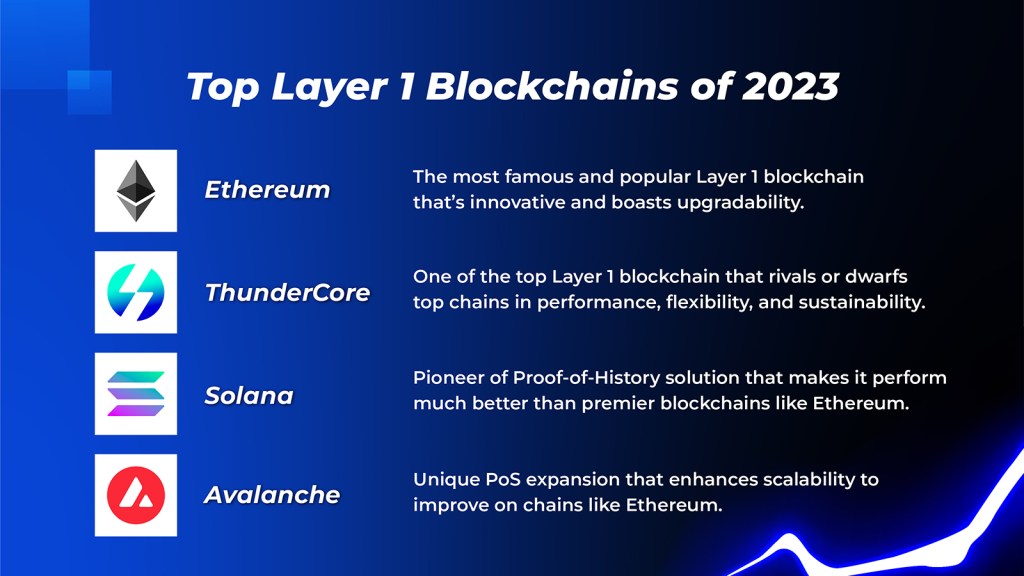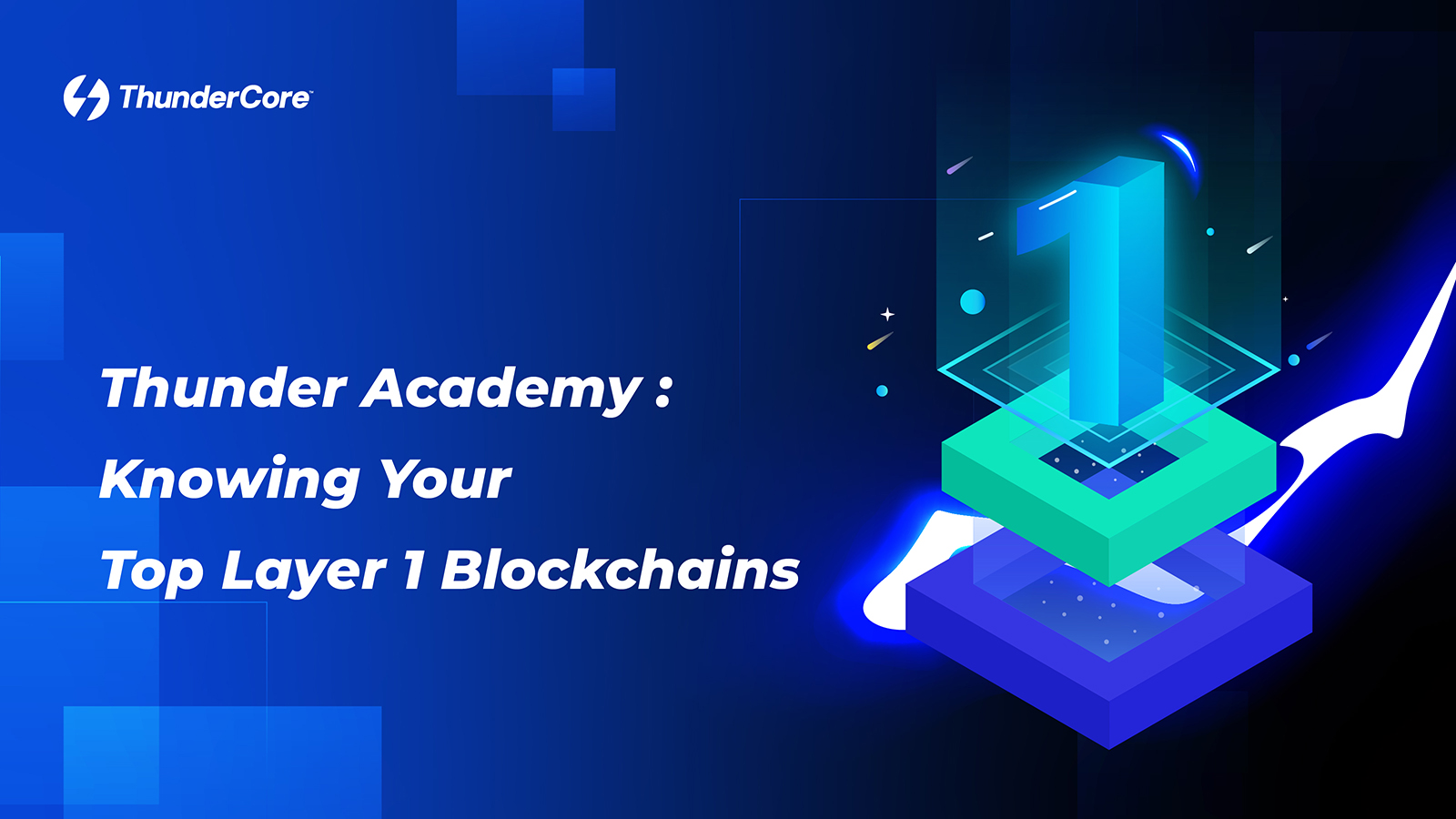From Ethereum to our very own ThunderCore, let’s talk about some top Layer 1 blockchains, what they offer, and their similarities/differences.
Before we begin, let’s first review what Layer 1 blockchains are. Layer 1 (L1) blockchains refer to the foundational protocol that serves as the blockchain’s core. L1 sets up a network that can complete/record transactions and provide security, marking the fundamentals of blockchain technology. The way each L1 blockchains builds its network, while similar for foundational characteristics like decentralization, often takes very different approaches.
Another feature of L1 is setting up the infrastructure so additional layers and applications like Dapps can be added. Serving as the base layer, L1 is the identity of a blockchain. From scaling transactions per second (TPS) to offering PoW or PoS, everything connects to L1.
Please refer to this article for more information on the layers of blockchain. Here’s a list of the blockchains we will talk about, and let’s dive into the top Layer 1 blockchains and what they offer!

Ethereum
When discussing top Layer 1 blockchains, Ethereum (ETH) is the first to come to mind. Ethereum is a public blockchain (we will talk about private vs public in a future Thunder Academy post) that is permissionless, decentralized, and uses a PoS consensus mechanism (Introduced in 2022 through the Ethereum 2.0 merge).
Ethereum’s single biggest advantage is its size. It is the largest ecosystem and has gone through billions of transactions. With its ability to go for Layer 2 solutions, this blockchain offers room for constant upgrades and innovation, including the potential for new functionalities and applications.
Sounds too good to be true? Ethereum has a couple of very noticeable disadvantages. Due to its popularity, Ethereum’s gas fee can sometimes spike to be quite expensive. This can be off-putting for users, especially when compared to the lower rates of other blockchains. Another disadvantage is the lack of a token limit. Unlike Bitcoin, there’s no limit to the Ether token supply, so token inflation is a potential problem. The most critical disadvantage is scalability issues. While Ethereum can adopt Layer 2 solutions, scalability is still an issue that constantly has to be worked on. It should be noted, however, that Ethereum is managing these issues through solutions like burning Ether to control price and optimizing scalability/gas fees.
Noting the advantages and disadvantages, Ethereum is and will remain one of the top Layer 1 Blockchain for years to come.
ThunderCore
ThunderCore (TT) is another prime Layer 1 blockchain with performance comparable to all the other top blockchains, exceeding that of Ethereum. Founded in Silicon Valley in 2017 to provide a robust infrastructure for DApps and the broader DeFi ecosystem, ThunderCore is a PoS-based network focusing heavily on performance, sustainability, and energy efficiency.
Comparing ThunderCore with Ethereum, ThunderCore holds many advantages over the blockchain giant. Boasting higher TPS and a block time of 1 second compared to Ethereum’s ~15 seconds, ThunderCore offers scalability and better performance. The transaction fee for ThunderCore is also much lower compared to Ethereum. Having high scalability and low fees is what makes ThunderCore stand out.
Another core characteristic that ThunderCore has is EVM compatibility. This means that it is compatible with all Ethereum smart contracts and tools. If Ethereum can scale to Layer 2 to enhance scalability, so can ThunderCore. ThunderCore also offers interoperability that furthers cross-chain compatibility with the likes of Ethereum, Binance Smart Chain, and Huobi Eco Chain. These advantages and characteristics are significant in terms of making ThunderCore flexible, scalable, and interoperable.
With a focus on performance, which rivals and dwarfs that of other chains, ThunderCore is a top Layer 1 blockchain. ThunderCore boasts over 642 million total transactions and a stable community of investors that consistently pushes its potential to newer levels, making it a strong contender in the blockchain world.
Solana
Solana (SOL) is another blockchain similar to Ethereum but seeks to be the upgraded version with much better scalability. The key unique feature of Solana is its proof-of-history consensus mechanism. PoH is a scalability solution that reduces the amount of data that needs to be stored and verified, enhancing TPS and overall load management. By being the first blockchain to utilize the PoH concept, Solana can push scalability above that of Ethereum, marking itself as a pioneer.
While PoH has plenty of advantages, there are still drawbacks to this solution. The biggest issue is needing a PoH generator (a trusted third party). This makes it so the network is heavily influenced by the reliability of the PoH generator, marking an issue with stability. Also, Solana has the same inflation problem as Etheruem as there’s no token supply limit.
Solana is a top Layer 1 blockchain, and while it’s not as massive as Ethereum, it compensates by having way better performance and cost efficiency. Through having some of the best fee rates and speed, Solana will remain relevant as a top blockchain.
Avalanche
Avalanche (AVAX) is another top Layer 1 blockchain that focuses on tackling the blockchain trilemma. Building on the PoS system, Avalanche has a unique consensus mechanism called the Snow consensus protocol.
This protocol separates itself into three chains to increase scalability and efficiency and uses a random sampling of the network’s nodes to validate transactions. Decentralization is tackled by having these validators bounce consensus amongst each other. Scalability is solved as this consensus mechanism allows for speed and affordability, processing up to 4,500 TPS compared to Ethereum’s 15.
The most glaring drawback for Avalanche, however, is the “entrance requirement” to become a validator. To become a validator, one needs to have a stake of 2000 AVAX tokens, which would be over $30,000. Avalanche is also known to be lax and too forgiving for careless validators, marking down its reliability.
Noting the pros and cons of Avalanche, this Layer 1 blockchain uses its unique mechanism to continue gathering momentum as a top chain.
Layer 1 Blockchains: Achieving the Perfect Balance
There are an insane number of Layer 1 blockchains out there, and what separates one from the other is their approach to managing the balance between performance, scalability, and stability. With Ethereum serving as the baseline blockchain for comparison, every other competitor looks to offer something a little extra.
By understanding what the top Layer 1 blockchains are, it’s easy to dive deeper into different consensus mechanisms or blockchain structuring. This, in turn, will offer a better understanding of what to expect from these blockchains and which one might be better for you.
What’s Next?
With Thunder Academy, we will continue exploring other aspects of blockchain, including the different types, blockchains for other layers, etc. We hope to provide information so our users can better understand the landscape and participate in the crypto/blockchain world.
Next time, we will move along and talk about the top Layer 2 blockchains and touch on comparisons, their unique proposals, and how they stack up against each other!
